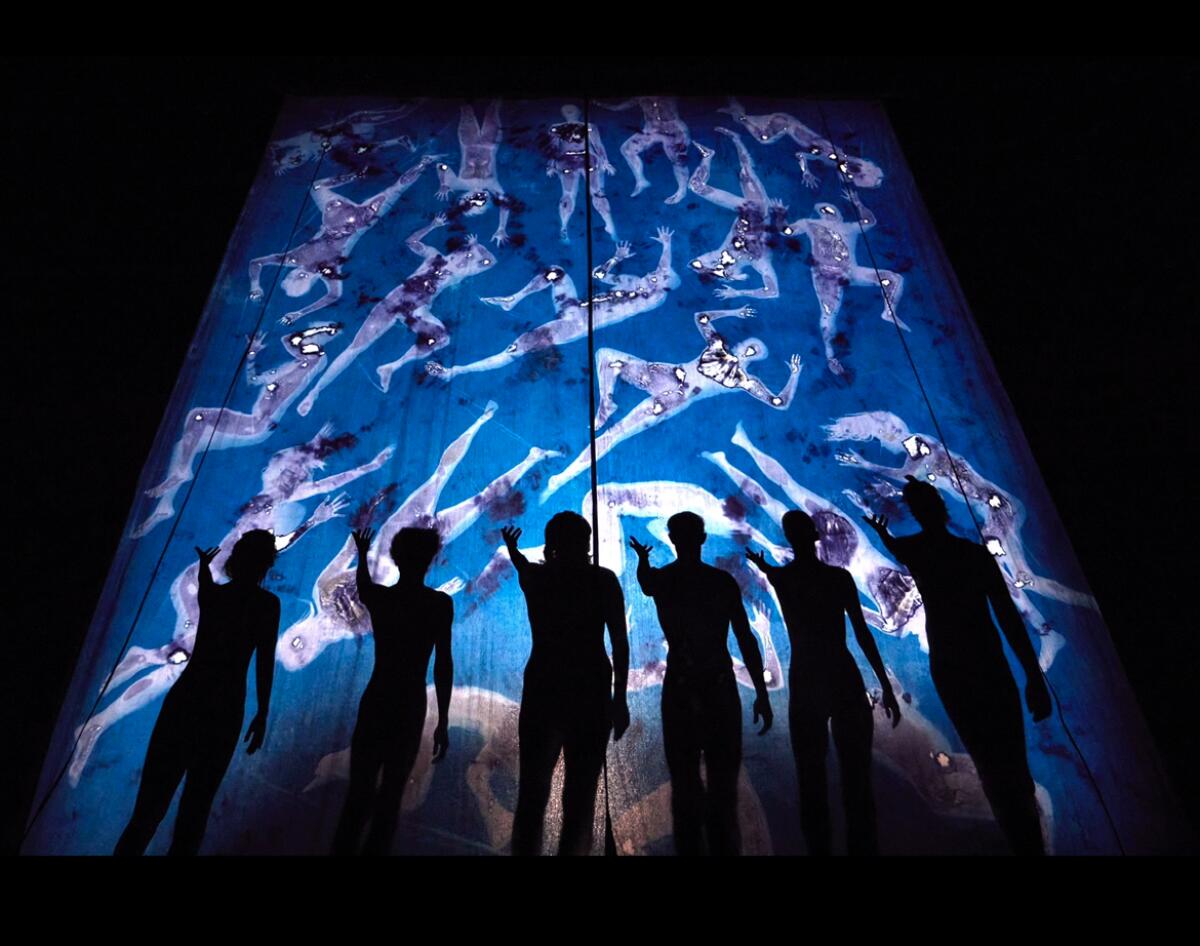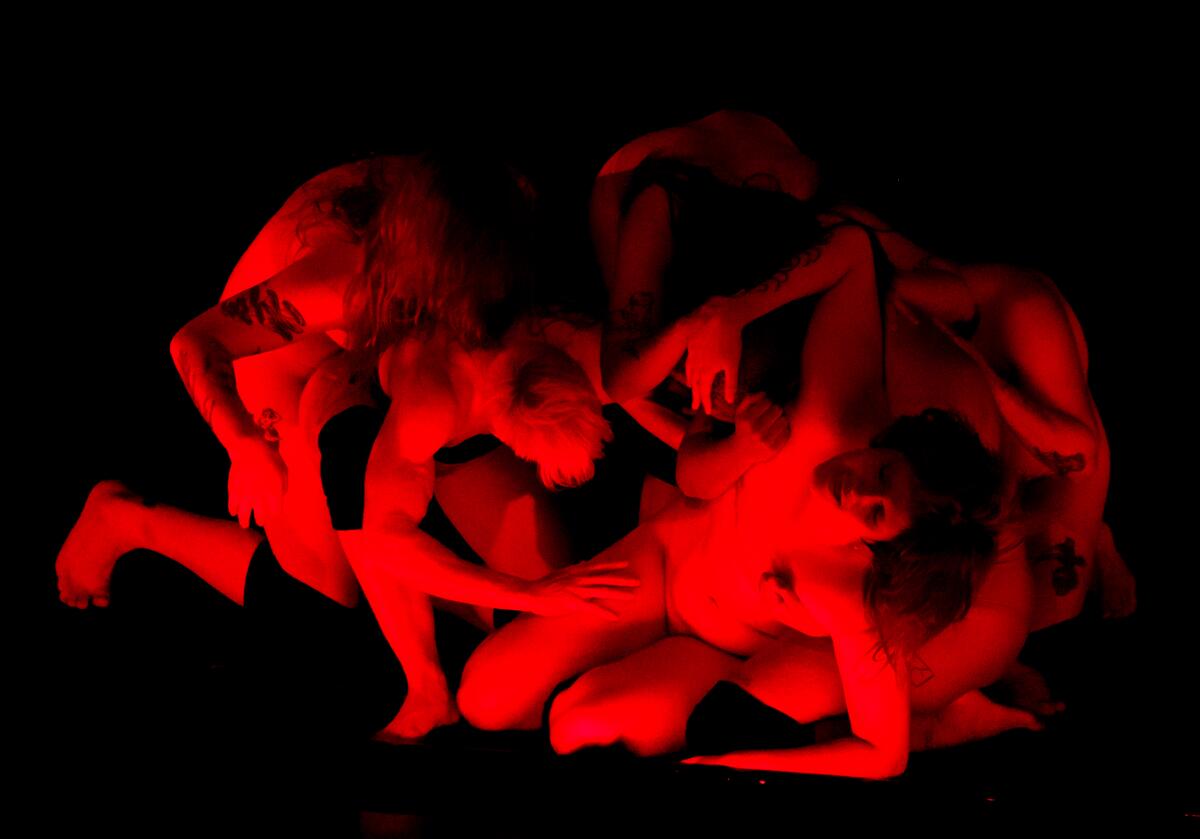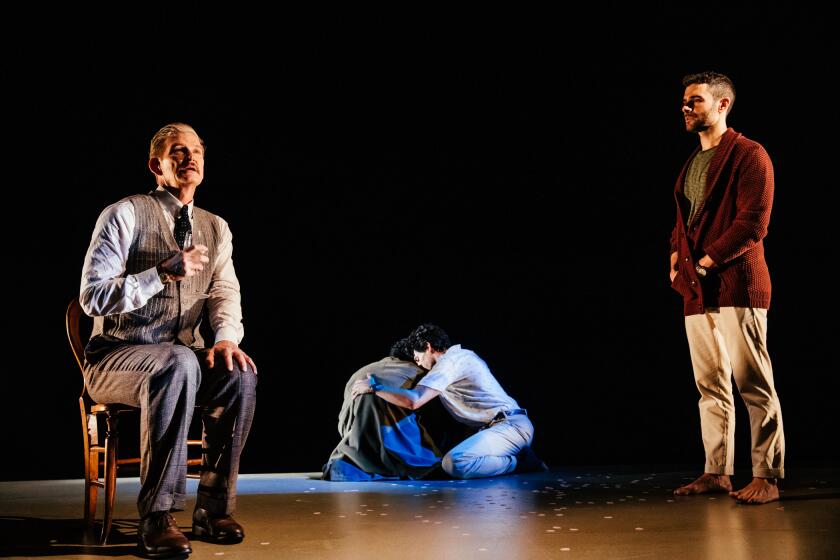In Cassils’ first ever dance piece, trans bodies made movement — and a striking canvas

- Share via
There was a moment, in the opening minutes of “Human Measure,” of extraordinary tenderness. A row of dancers bathed in red light kneel before a narrow reflecting pool at the edge of the stage, their arms extended in a gesture of supplication. As their bodies torque and lean to the right, each dancer ends up holding the head of the dancer before them with open palms.
The embodiment of mutual support was poignant given the context: Onstage were half a dozen transgender and nonbinary performers, largely unclothed, at a time when violence against trans and gender non-conforming people in the United States is at a peak. Last year was the deadliest on record, according to the Human Rights Campaign, which has been tracking attacks for nearly a decade. It is also a moment of rising discriminatory legislation targeting LGBTQ people in states across the U.S. In a time of persecution, “Human Measure,” which was on view at REDCAT for three engagements last week, showed trans bodies finding connection with one another.
It is the first work of dance by Cassils, a Canadian-born artist (now based in New York City) who is best known for their demanding performance art pieces. (Cassils uses they/them pronouns.) In a 2011 performance, the artist stood against an ice sculpture that depicted the body of Tiresias, a Greek mythological prophet who lived as both man and woman. Over the course of hours, the artist’s body heat melted down this idealized Classical form to water.
In a work titled “Pissed,” from 2017, they crafted an installation out of their own urine to protest the Trump administration’s rollback of an executive order that allowed trans students to use the bathroom that matched their gender identity. It was a piece filled with rage, but also wry in its presentation — the containers and their elegant installation evoking the stripped-down forms of Minimalism.

The artist Texas Isaiah celebrates the black transgender and gender-nonconforming community with VSCO and the Marsha P. Johnson Institute.
“Human Measure” made equally urgent points about where trans people find themselves politically — in moving, gorgeous ways.
First presented at the Home arts center in Manchester, England, last year, the piece is a collaboration between Cassils and Jasmine Albuquerque, a Los Angeles choreographer who co-founded the experimental dance company WIFE and has produced a range of other commercial and artistic work, including music videos for performers such as St. Vincent and Devendra Banhart. Set to an original sonic piece by composer Kadet Kuhne — music that felt like one throbbing, slowly evolving trance-like note — the choreography opened with that tender gesture of support before segueing into more ecstatic states.
There was erotic sensuousness and boundless joy, with the dancers at one point echoing the extravagant arm motions common to performers in the underground ballroom scene. There was also violence, with one sequence evoking a cruel assault.
Dance is ephemeral, but “Human Measure” leaves behind a remarkable physical object.
The entire performance took place on a large muslin canvas that had been treated with cyanotype solution. This substance, dating back to photography’s earliest days in the 19th century, creates prints in shades of blue by exposing a mix of chemicals to ultraviolet light. Throughout much of the show, the performers danced only in red light — a moody ambience interrupted on several occasions by a flash wall at the rear of the stage that bathed the theater in blinding light. (The lighting design was by Christopher Kuhl.) This periodic blast of white not only gave the performance an unsettling quality, it functioned as a photographic apparatus — imprinting the dancer’s bodies onto the treated canvas below.
The cyanotype is a statement about presence as well as a riff on art history. Not only is the solution rooted in photography’s roots and the troubled legacies of the color blue, the imprint of bodies in blue nods to artist Yves Klein’s “Anthropometries” series, in which naked women bathed in blue paint were wielded by the artist as “human paintbrushes” against a large canvas.
In Cassils’ version, however, those bodies aren’t passive; they’re given agency.
The Geffen Playhouse production of ‘The Inheritance’ superbly realizes playwright Matthew López’s vision. At 6½ hours long, it’s worth every minute.
At the end of the performance, the dancers gathered the muslin and deposited it into the tray of water at the front of the stage, lovingly bathing its every fold — and essentially developing a cyanotype print before our eyes. The only sound onstage during this time was the ragged breath of the performers and the sound of the water lapping at the pool. Once the process was complete, Cassils and a fellow dancer used ropes to hoist the massive print, revealing the image to the audience gathered in the room.
There were the ghostly outlines of the dancers’ bodies framed in a pool of blue. Bodies that were each singular in their composition and height and in the traits that define them, but at the end of the day just bodies — no different from other bodies, bodies like yours and mine.
More to Read
The biggest entertainment stories
Get our big stories about Hollywood, film, television, music, arts, culture and more right in your inbox as soon as they publish.
You may occasionally receive promotional content from the Los Angeles Times.












